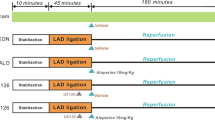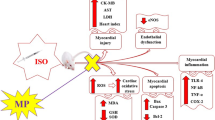Abstract
12/15-Lipoxygenase (LOX) is a member of the LOX family that catalyzes the step from arachidonic acid to hydroxy-eicosatetraenoic acids (HETEs). Previous studies demonstrated that 12/15-LOX plays a critical role in the development of atherosclerosis, hypertension, heart failure, and other diseases; however, its role in myocardial ischemic injury was contraversal. Here, we investigated the inhibition of 12/15-LOX by baicalein on acute cardiac injury and dissected its molecular mechanism. In a mouse model of acute ischemia/reperfusion (I/R) injury, 12/15-LOX was significantly upregulated in the peri-infarct area surrounding the primary infarction. In cultured cardiac myocytes, baicalein suppressed apoptosis and caspase 3 activity in response to simulated ischemia/reperfusion (I/R). Moreover, administration of 12/15-LOX inhibitor, baicalein, significantly attenuated myocardial infarct size induced by I/R injury. Moreover, baicalein treatment significantly inhibited cardiomyocyte apoptosis, inflammatory responses and oxidative stress in the heart after I/R injury. The mechanisms underlying these effects were associated with the activation of ERK1/2 and AKT pathways and inhibition of activation of p38 MAPK, JNK1/2, and NF-kB/p65 pathways in the I/R-treated hearts and neonatal cardiomyoctes. Our data indicated that 12/15-LOX inhibitor baicalein can prevent myocardial I/R injury by modulation of multiple mechanisms, and suggest that baicalein could represent a novel therapeutic drug for acute myocardial infarction.









Similar content being viewed by others
References
Armstrong SC (2004) Protein kinase activation and myocardial ischemia/reperfusion injury. Cardiovasc Res 61:427–436
Eefting F, Rensing B, Wigman J et al (2004) Role of apoptosis in reperfusion injury. Cardiovasc Res 61:414–426
Frangogiannis NG, Smith CW, Entman ML (2002) The inflammatory response in myocardial infarction. Cardiovasc Res 53:31–47
Kayama Y, Minamino T, Toko H et al (2009) Cardiac 12/15 lipoxygenase-induced inflammation is involved in heart failure. J Exp Med 206:1565–1574
Yigitkanli K, Pekcec A, Karatas H et al (2013) Inhibition of 12/15-lipoxygenase as therapeutic strategy to treat stroke. Ann Neurol 73:129–135
Guadall A, Orriols M, Alcudia JF, Cachofeiro V, Martinez-Gonzalez J, Rodriguez C (2011) Hypoxia-induced ROS signaling is required for LOX up-regulation in endothelial cells. Front Biosci (Elite Ed) 3:955–967
van Leyen K, Kim HY, Lee SR, Jin G, Arai K, Lo EH (2006) Baicalein and 12/15-lipoxygenase in the ischemic brain. Stroke 37:3014–3018
Natarajan R, Nadler JL (2004) Lipid inflammatory mediators in diabetic vascular disease. Arterioscler Thromb Vasc Biol 24:1542–1548
Reilly KB, Srinivasan S, Hatley ME et al (2004) 12/15-Lipoxygenase activity mediates inflammatory monocyte/endothelial interactions and atherosclerosis in vivo. J Biol Chem 279:9440–9450
Taylor AM, Hanchett R, Natarajan R et al (2005) The effects of leukocyte-type 12/15-lipoxygenase on Id3-mediated vascular smooth muscle cell growth. Arterioscler Thromb Vasc Biol 25:2069–2074
Woo AY, Cheng CH, Waye MM (2005) Baicalein protects rat cardiomyocytes from hypoxia/reoxygenation damage via a prooxidant mechanism. Cardiovasc Res 65:244–253
Sexton A, McDonald M, Cayla C, Thiemermann C, Ahluwalia A (2007) 12-Lipoxygenase-derived eicosanoids protect against myocardial ischemia/reperfusion injury via activation of neuronal TRPV1. FASEB J 21:2695–2703
Tsutsumi YM, Patel HH, Huang D, Roth DM (2006) Role of 12-lipoxygenase in volatile anesthetic-induced delayed preconditioning in mice. Am J Physiol Heart Circ Physiol 291:H979–H983
Zhang Y, Zeng Y, Wang M et al (2011) Cardiac-specific overexpression of E3 ligase Nrdp1 increases ischemia and reperfusion-induced cardiac injury. Basic Res Cardiol 106:371–383
Gao E, Lei YH, Shang X et al (2010) A novel and efficient model of coronary artery ligation and myocardial infarction in the mouse. Circ Res 107:1445–1453
Ha T, Hua F, Li Y et al (2006) Blockade of MyD88 attenuates cardiac hypertrophy and decreases cardiac myocyte apoptosis in pressure overload-induced cardiac hypertrophy in vivo. Am J Physiol Heart Circ Physiol 290:985–994
Li HH, Kedar V, Zhang C et al (2004) Atrogin-1/muscle atrophy F-box inhibits calcineurin-dependent cardiac hypertrophy by participating in an SCF ubiquitin ligase complex. J Clin Investig 114:1058–1071
Li HH, Willis MS, Lockyer P et al (2007) Atrogin-1 inhibits Akt-dependent cardiac hypertrophy in mice via ubiquitin-dependent coactivation of Forkhead proteins. J Clin Investig 117:3211–3223
Xu CW, Zhang TP, Wang HX, Yang H, Li HH (2013) CHIP enhances angiogenesis and restores cardiac function after infarction in transgenic mice. Cell Physiol Biochem 31:199–208
Yang K, Zhang TP, Tian C, Jia LX, Du J, Li HH (2012) Carboxyl terminus of heat shock protein 70-interacting protein inhibits angiotensin II-induced cardiac remodeling. Am J Hypertens 25:994–1001
Sakamoto M, Minamino T, Toko H et al (2006) Upregulation of heat shock transcription factor 1 plays a critical role in adaptive cardiac hypertrophy. Circ Res 99:1411–1418
Sano M, Minamino T, Toko H et al (2007) p53-induced inhibition of Hif-1 causes cardiac dysfunction during pressure overload. Nature 446:444–448
Toko H, Takahashi H, Kayama Y et al (2010) Ca2+/calmodulin-dependent kinase IIdelta causes heart failure by accumulation of p53 in dilated cardiomyopathy. Circulation 122:891–899
Natarajan R, Yang DC, Lanting L, Nadler JL (2002) Key role of P38 mitogen-activated protein kinase and the lipoxygenase pathway in angiotensin II actions in H295R adrenocortical cells. Endocrine 18:295–301
Jin G, Arai K, Murata Y et al (2008) Protecting against cerebrovascular injury: contributions of 12/15-lipoxygenase to edema formation after transient focal ischemia. Stroke 39:2538–2543
Pidgeon GP, Tang K, Cai YL, Piasentin E, Honn KV (2003) Overexpression of platelet-type 12-lipoxygenase promotes tumor cell survival by enhancing alpha(v)beta(3) and alpha(v)beta(5) integrin expression. Cancer Res 63:4258–4267
Logue SE, Gustafsson AB, Samali A, Gottlieb RA (2005) Ischemia/reperfusion injury at the intersection with cell death. J Mol Cell Cardiol 38:21–33
Lopez-Neblina F, Toledo AH, Toledo-Pereyra LH (2005) Molecular biology of apoptosis in ischemia and reperfusion. J Investig Surg 18:335–350
Wen Y, Gu J, Vandenhoff GE, Liu X, Nadler JL (2008) Role of 12/15-lipoxygenase in the expression of MCP-1 in mouse macrophages. Am J Physiol Heart Circ Physiol 294:H1933–H1938
Bowden RA, Ding ZM, Donnachie EM et al (2002) Role of alpha4 integrin and VCAM-1 in CD18-independent neutrophil migration across mouse cardiac endothelium. Circ Res 90:562–569
Feng Y, Zhao H, Xu X et al (2008) Innate immune adaptor MyD88 mediates neutrophil recruitment and myocardial injury after ischemia-reperfusion in mice. Am J Physiol Heart Circ Physiol 295:H1311–H1318
Gu J, Liu Y, Wen Y, Natarajan R, Lanting L, Nadler JL (2001) Evidence that increased 12-lipoxygenase activity induces apoptosis in fibroblasts. J Cell Physiol 186:357–365
Gu J, Wen Y, Mison A, Nadler JL (2003) 12-lipoxygenase pathway increases aldosterone production, 3′,5′-cyclic adenosine monophosphate response element-binding protein phosphorylation, and p38 mitogen-activated protein kinase activation in H295R human adrenocortical cells. Endocrinology 144:534–543
Li H, Gao F, Ma L et al (2012) Therapeutic potential of in utero mesenchymal stem cell (MSCs) transplantation in rat foetuses with spina bifida aperta. J Cell Mol Med 16:1606–1617
Kuhn H, Romisch I, Belkner J (2005) The role of lipoxygenase-isoforms in atherogenesis. Mol Nutr Food Res 49:1014–1029
Heusch G, Boengler K, Schulz R (2008) Cardioprotection: nitric oxide, protein kinases, and mitochondria. Circulation 118:1915–1919
Zhang T, Yang D, Fan Y, Xie P, Li H (2009) Epigallocatechin-3-gallate enhances ischemia/reperfusion-induced apoptosis in human umbilical vein endothelial cells via AKT and MAPK pathways. Apoptosis 14:1245–1254
Baines CP, Molkentin JD (2005) STRESS signaling pathways that modulate cardiac myocyte apoptosis. J Mol Cell Cardiol 38:47–62
Wen Y, Gu J, Liu Y, Wang PH, Sun Y, Nadler JL (2001) Overexpression of 12-lipoxygenase causes cardiac fibroblast cell growth. Circ Res 88:70–76
Acknowledgments
This work was supported by China National Natural Science Funds (Nos. 81025001, 81330003 and 510025), Chang Jiang Scholar Program and the Beijing high-level talents program (PHR20110507).
Conflict of interest
The authors declare that they have no conflict of interest.
Author information
Authors and Affiliations
Corresponding author
Rights and permissions
About this article
Cite this article
Song, L., Yang, H., Wang, HX. et al. Inhibition of 12/15 lipoxygenase by baicalein reduces myocardial ischemia/reperfusion injury via modulation of multiple signaling pathways. Apoptosis 19, 567–580 (2014). https://doi.org/10.1007/s10495-013-0946-z
Published:
Issue Date:
DOI: https://doi.org/10.1007/s10495-013-0946-z




